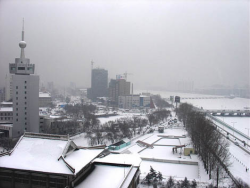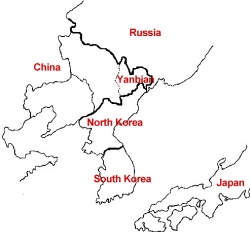China’s Yanbian Province Changing

LFNKR Staff Member Visits Yanbian, China
For the first time in more than ten years, I visited China’s Yanbian Korean Autonomous Prefecture. Recently, China has undergone remarkable economic development, and its impact has reached even China’s northeastern region of Yanbian. From my previous visit, I recall low-rise buildings scattered about and old Soviet-made cars on dilapidated roads.
Now, however, I saw no Soviet-made cars, and there are many more modern buildings in the city. Highways have been built, and construction is underway for a high-speed bullet train.
On this trip I also visited the rural areas but saw hardly any people. Those I spoke with told me that among the Chinese Koreans, the majority of young, able-bodied workers have left to work in South Korea, leaving behind only old people and children. Even though it is called Korean Autonomous Prefecture, the proportion of ethnic Koreans has plummeted. Meanwhile, the influx of Han Chinese continues, causing fears that the Korean Autonomous Prefecture may soon come to an end.
Even in the city shops, fewer people spoke Korean. In their place are far more Han Chinese who understand no Korean.
Before visiting LFNKR’s facility, I purchased drinking water and candy at a local supermarket to give to the children. I also went to the local market to buy ingredients for Japanese curry, which the children love (the curry seasoning mix is not sold in this region, so I had brought some with me from Japan). I found that the supermarkets and stores in China are now overflowing with a variety of goods.
When I arrived at the facility, the staff and many of the children came out to greet me, though some of the smaller children were still asleep. The older elementary school and middle school students were enjoying soccer in the courtyard. The children were all very friendly with big smiles brightening their faces.
While waiting for the curry to be cooked, I taught them origami, in which they showed great interest. Of course, Chinese schools also teach origami, so they were very good at folding the paper cranes and boats.
On the walls of the dining hall, the children’s report cards were posted in columns. Every month the children who excel are recognized. Also, in one corner was a locker containing books provided by the local government library.
In the yard were sheds, one for coal and another for food supplies. In the courtyard I saw a large outdoor stove built by the people at the facility. A big iron pot sitting on the stove is used to make dishes that cannot be made in the facility’s kitchen, such as boiled sweet potato or corn, poshintang (dog meat stew), and boiled whole pig.
Later, I also visited Tumen, but the North Korean detention center, which was once in the city, has now been moved to the hills out in the suburbs. On the Chinese side of the bridge leading to Nanyang, a new barbed wire fence has been set up.
On this trip, I saw one side of the harsh reality of the Chinese-Korean border, and it left me with mixed feelings.







